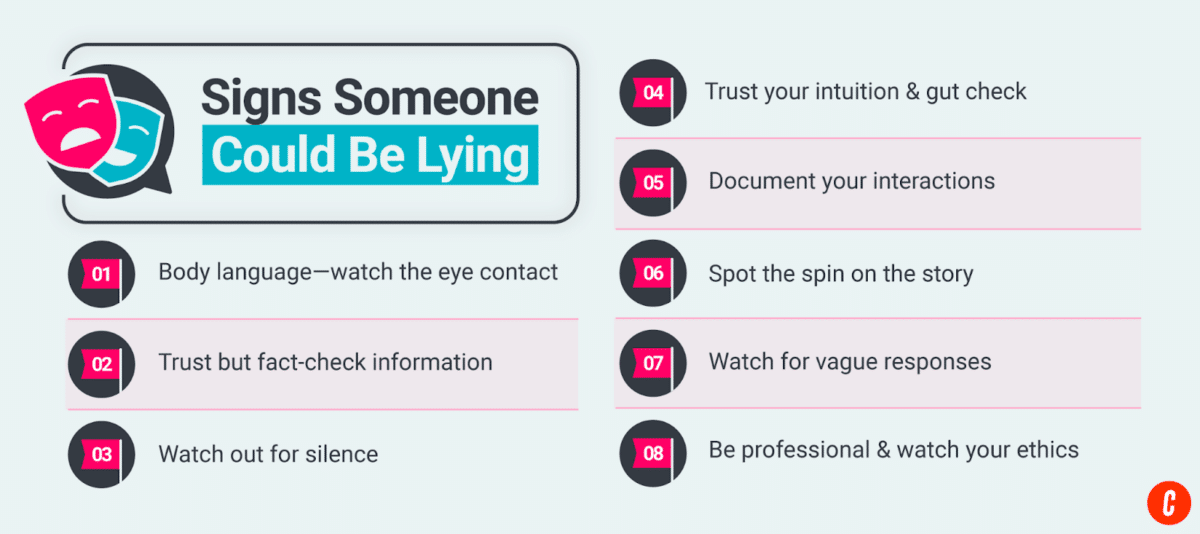Nobody wants to believe their clients are lying to them. And often, they aren’t. However, people lie for various reasons. You shouldn’t pry into the why but stay focused on the client and the transaction. You may not be able to figure out the motivation behind the lie, but sharpening your skills to detect a lie is a must-have for any real estate professional’s toolbox. I’ll dive into the signs of recognizing a potential lie and how to deal with a lying client. Let’s get started.

I want to note to our readers that often, what you might perceive as lying could just be a new client feeling uncomfortable. Cultural differences could also come across as guarded or closed off. Be mindful that just as you’re trying to read your clients to see if you can trust them, they’re doing the same to you. They need to know they can trust you. So before making assumptions, just ask your clients what they’re thinking or what’s going on. Just because someone could be lying to you doesn’t mean they are lying to you.
1. Recognize the Signs in Their Body Language
When you first meet your clients, you might not know them personally. Your goal is to build rapport during one of your first interactions and to put them at ease so you can understand and observe your client’s natural body language and communication style. That baseline is essential to knowing how someone acts when they’re being truthful.
According to Chris Voss, former FBI hostage negotiator and author of “Never Split the Difference,” the majority of our communication—55%, in fact—comes from our face and body language. What you’re looking out for here is your client’s tone of voice and nonverbal cues. Think:
- Lack of eye contact
- Itching and fidgeting
- High-pitched voice
- Change in their complexion
- Sweaty palms or forehead
- Vocal fill (“uh,” “like,” and “um”)
While it may mean they’re lying, they could also be looking to conceal personal information. However, when your clients veer into avoiding direct questions about simple things, like areas of interest or how much they can afford, that’s a red flag.
-
Example : Let’s say you have a client ready to see a home, and you ask if they’ve spoken with a lender. They shift their eyes downward, look away, and quietly say “yes,” but they’ve only handed you a quick prequalification they got online. That’s much different than a pre-approval from a lender. Perhaps they don’t know the difference, but this is a chance for you to jump in and educate. Always assume positive intent.
2. Trust but Verify Their Information
“Trust but verify” was something my first managing broker told me. The adage rings true in real estate for a reason. Take your client’s word, but you must do your own diligence as a real estate professional. This means if your sellers say they got the roof replaced last year, but you see that the shingles have a ton of wear, you might need to consider pulling the permit history report. After all, according to CRES, a nationally recognized Errors & Omissions (E&O) insurance provider, one in five real estate lawsuits are due to an issue with permits.
-
Example : Your buyers found their perfect home—turns out it’s back on the market from falling out of contract. Your buyers want to make an offer, and you ask, “What happened on the last deal?” The listing agent tells you that the last buyers “noticed something during the inspection.” Then you see that the seller’s property disclosure hasn’t been updated since the listing went live. It’s your responsibility to ask the listing agent to verify if there is an updated property disclosure—after all, the last buyers backed out for a reason. Once the sellers are aware of a significant service or system issue, they must disclose the issue (in most cases).
3. Not Responding to Your Communication

Interestingly, research tells us how our clients communicate doesn’t matter much in detecting lies. A Northwestern University communications researcher studied lies in text messaging. When participants were asked to look at their 30 most recent text messages, a fifth of respondents said there were no lies at all, and the majority said that 10% or fewer of their texts contained lies. In other words, studies found that most people are truthful—toward strangers and even via social media and texting. On the whole, people aren’t trying to lie. Sometimes, social media can skew toward misinformed information, but that’s more due to the uninformed public rather than intentional deception.
In other words, you may not have a lying client just because they prefer texting. If your client only communicates via text, your red flag here should be a lack of a response. While you might get frustrated with your client’s preference for “just texting,” your client could have a good reason for it. The same study showed that the number of lies doesn’t increase depending on the form. Just ask your clients the method they prefer and adapt.
-
Example : Nowadays, having clients who only communicate via email or text is common. Other times, clients only want to talk via phone. However, here’s a red flag: they don’t respond for a few days or outright refuse to talk via phone or email. For example, you tour a home, then your clients ghost you. Next time you connect, ensure you’re still on the same page. Time is crucial in real estate (and communication)!
📌 Pro Tip
Language can blur the line between truth and fiction. Watch out for a guarded tone, repeated questions, and vague statements from your clients. Don’t be afraid to press questions, especially those to which you need an answer, like a pre-approval letter or a client’s lender information.
4. Trust Your Intuition (& Your Gut!)
This one might come with time and experience, but if something feels off, it probably is. Use professional judgment here—try to figure out how to verify things to ensure you don’t waste your efforts chasing after dead ends. When looking at how to deal with a lying client, it helps to know the intentions behind the lies.
While studies vary on why people lie, impression management is one of the most popular reasons. These types of folks really care about what others think of them, so they might make up lies to help their situation. They see these white lies as having good intentions.
Bella DePaula, Ph.D., asks us to think about two kinds of lies: self-serving lies and kindhearted lies:
Self-serving lies are the ones people tell to make themselves look better or to spare themselves from embarrassment, punishment, or blame, or from getting their feelings hurt. You know the kind: You claim to have performed better than you really did or you deny that you did something bad or embarrassing.
Kindhearted lies are told with the intent of making another person look better or feel better, or to spare them from embarrassment, punishment, or blame, or from getting their feelings hurt.
“You look great!”
“What a terrific dinner!”
“I know just how you feel.”
-
Example : People may not lie to deceive you but to spare your feelings. Think of those showings where the feedback says, “I think my clients loved it … they might plan to make an offer,” but the offer doesn’t arrive. When you call the agent a few days later, it turns out that their buyers just put an offer in on another house. The agent says that they didn’t want to come across as rude.
If you want to learn more about personality types and the different types of lies that men and women tell, check out DePaula’s insightful article, “Who Lies?” in Psychology Today.
5. Document Your Interactions to Spot Lies
So you’ve seen a few signs of lying from your clients. What should you do next? Simple: While lie detection isn’t easy, one way to protect yourself and your business is to document every interaction. This documentation is why having and using a real estate customer relationship manager (CRM) is so important. Sync up your documents and emails with your client files to make sure you’re on track and on the same page as your client.
Your clients may often not try to lie to you as much as “save face” for themselves. It’s about education for your clients. They may be unaware of how their behavior is coming across—going back to why building rapport with your clients is vital before jumping into a showing and a contract.
-
Example : A woman is interested in purchasing a small, one-bedroom condo. She seems guarded and doesn’t give you much information to help her find a home. One day, she gets a call from one of her children. You didn’t know she had a family. Come to find out, she lets you know that she is looking to leave her husband and wants to leave him off the deed. She’s trusting you to keep the transaction quiet.
6. Try to Spot Inconsistent or Contradictory Stories
While perhaps your clients don’t understand the difference between a prequalification and a pre-approval, that’s easy to explain and help your client understand. The difference is hearing different stories whenever you ask a question. This contradiction could be a red flag. For example, if your new buyers say they’re moving cities due to a new job, but it turns out they start sending you homes to view in the next neighborhood over, you have to find out why they’re giving you (what seems like) an excuse. Maybe you don’t have a lying client—just one who can’t decide where to live!
Don’t be afraid to have those open conversations. If you’re seeing the stories change or feel like you’re getting excuses from your clients, it’s time to talk about expectations versus reality. Let them know that you must understand the entire situation to serve them best.
-
Example : You get a lead from a brother and sister looking to sell—it’s an inheritance listing. Once you snag the listing appointment and arrive, the woman tells you her brother is traveling to another state for work but will do what she decides. You write up the paperwork, get her signature, and wait for the brother to sign. A week later, she informs you that the brother has listed the home with another agent. It would have been wise to grab his information and figure out his side of the transaction.
7. Watch Out for Vague Responses
Listen: the real estate industry moves fast. Interest rates and home availability change almost daily. We don’t have time for vague responses and veiled communication. If you’re getting the runaround, it’s time to ask why.
Nobody likes being ignored or given the cold shoulder. If you’re experiencing this from your client, ask a few probing questions to get more information, like “How are things outside of the transaction lately?” or “How are you feeling about this change?”
-
Example : A regular weekly check-in is essential for you and your client. If you’re feeling them pull away or not receiving prompt responses, they could have dozens of reasons for being guarded. For example, when you’ve had a listing on the market for a while, you might feel like your sellers are pulling away from you. They could just be busy—you’ll never know unless you ask. This vagueness is why you must check in regularly to ensure everybody’s on the same page.
8. Always Remember Your Professionalism & Ethics
While you want to trust your intuition, keep ethics in mind. Ensure you’re respectful of other cultures and traditions. Don’t assume anything based on your client’s appearance, dress, or speech patterns. It’s sometimes better to shrug off and move on rather than get hung up on what could have been a lie. If you think you’ve spotted a lie, just ask for clarification.
And, of course, it’s important to keep your safety as a real estate agent in mind as well. Trust your clients, but don’t be too trusting (remember—trust but verify). Try to avoid sharing a vehicle with a stranger or texting after hours, and ensure someone knows your location if you’re going to meet a client for the first time. You can never be too careful—better safe than sorry.
-
Example : Remember the legal implications of assumptions regarding your clients. Fair housing and anti-discrimination laws exist for a reason. You don’t want to be reported to your local regulatory board because you didn’t maintain professional conduct with a potential client.
Bringing It All Together
Remember that people tell lies for all sorts of reasons, and there’s a good chance you’ll occasionally encounter a few lies from your clients. In those cases, be understanding and try to educate your clients. After all, one of the most common untruths in real estate is to “save face”—even with a trusted party like their real estate agent!
While this field can make you jaded, it’s important to remember that as a professional, you should never assume bad intent on the part of your clients. Even if you’ve caught them in a lie, keep it to yourself until you can prove otherwise. After all, we never truly know another person’s intentions. As the motivational speaker Denis Waitley says, “Expect the best, plan for the worst, and prepare to be surprised.”
Are there techniques to spot a lie we didn’t cover? Share your experience in dealing with lies from clients: what strategies have worked for you?










Add comment